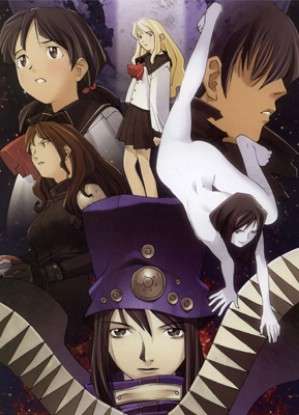Boogiepop Phantom

Boogiepop Phantom (Bugīpoppu wa Warawanai? in Japanese) is a 12-episode anime series premiered in 2000, animated by Madhouse. It's based on the Boogiepop light novels for young adults, adapting elements of both Boogiepop and Others and Boogiepop at Dawn while telling an independent story.
The plot revolves around a mysterious pillar of light that awakens mysterious powers on people in an unnamed Japanese city, the urban legend of a caped entity called Boogiepop whose origin may be related with the light pillar event, the disappearance of a group of high school students, and an escalating number of mysterious deaths that have a variable relation with the first three things mentioned above. The story is told non-chronologically by way of an incredible nest of flashbacks within flashbacks, and changes its narrative point of view with each chapter, but every character in the limelight tends to be not the most reliable of narrators, either because of either previous insanity, loss of sanity caused by their contact with the episode events, or being the one causing insanity in the first place.
Boogiepop Phantom is one of the premiere examples of Mind Screw. It's probably mentioned more often by comparison with Serial Experiments Lain than in any other context.
- All There in the Manual: It helps to have read Boogiepop At Dawn and Boogiepop And Others, in that order, to know what the Hell's going on.
- Anachronic Order
- Anime Theme Song: A funky, live action, grainy, 70's throwback depicting a drive into the city for a night out.
- The Anti-Nihilist: Panaru from episode 3, Life Can Be So Nice.
- Back from the Dead: Kuroda and The Manticore, in a sense; the former as a kind of living memory of his former self: similar to the "shadow" of Echoes that appears in Boogiepop At Dawn, the novel Kuroda dies in., and the latter a shadow of it's former self, having not actually died at the end of Boogiepop And Others as was previously believed.
- Badass Normal: Nagi Kirima, although the show's position on the Sliding Scale of Idealism vs. Cynicism means she still fails more often than she succeeds; also, debatably, the original Boogiepop it/herself..
- Continuity Lock Out: It is essential that you read the books mentioned in All There in the Manual: the show is really more like an epilogue to Dawn and a direct continuation of Others., or a key element of the over-arching plot: the true identity of Boogiepop Phantom and its relation to/the origin of The Manticore. will seem to come out of nowhere, and the final episode will be utterly incomprehensible.
- Creepy Child: Poom Poom, the balloon children, the robed girl.
- Deliberately Monochrome: Everything is really brown, but this ceases at the end of the series, when the funky electromagnetic effect in the air causing all the anomalies finally dissipates.
- Eldritch Abomination: the Manticore.
- Evil Counterpart
- False Camera Effects: vignette effect throughout.
- Flash Back: The entire plot is connected mysteriously to an event 1 month ago (which occurred at the end of Boogiepop and Others), with references to an event 5 years ago (explained in Boogiepop at Dawn).
- Note that the entire series, with the likely exception of the final episode, is made of flashbacks within flashbacks.
- Heroic Wannabe: Jonouchi. and Nagi Kirima, more or less.
- Hidden Depths: Shows up all the time, but most notably in a character who prevents herself from committing suicide.
- Huge Schoolgirl: Actually a past medical problem of one of the characters.
- Impossibly Cool Clothes: Boogiepop's cape and gravity-defying ribbon thing stand out from the austere realism of the rest of the clothing.
- Lower Deck Episode: Almost all of them. Alternately, the entire series is made up of separate days in the limelight from the plot of the novels.
- A Mind Is a Terrible Thing to Read: Yoshiki in episode 9, "You'll Never Be Young Twice"
- Mind Screw
- Hey, It's That Voice!: Crispin Freeman as Saotome/The Manticore.
- Living Memory
- Nothing Is Scarier
- Oracular Urchin: Manaka is a perfect example of this trope
- Pillar of Light
- Post Episode Trailer
- Real Is Brown: played with: during the first 11 episodes of the series the color palette is really brown and sepia, but the surreal events depicted on them are as real in universe as the one depicted in the extremely colorful final episode.
- Secret Identity
- Stepford Smiler: Misuzu. So very much.
- Twelve-Episode Anime
- Tomato in the Mirror: Kuroda
- Weaksauce Weakness: One straight out of Greek mythology-- Echoes is unable to speak other than to repeat people's words back at them.